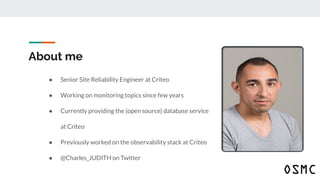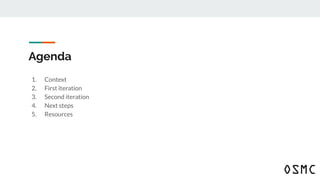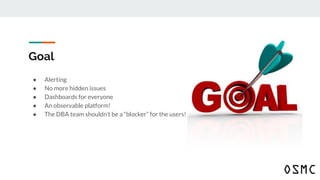OSMC 2019 | How to improve database Observability by Charles Judith
- 1. How to improve database observability? @Charles_JUDITH
- 2. About me ● Senior Site Reliability Engineer at Criteo ● Working on monitoring topics since few years ● Currently providing the (open source) database service at Criteo ● Previously worked on the observability stack at Criteo ● @Charles_JUDITH on Twitter
- 3. Agenda 1. Context 2. First iteration 3. Second iteration 4. Next steps 5. Resources
- 4. Context
- 5. Context ● Feedback from my experience at Criteo ● MariaDB/MySQL setup on multiple data centers ● Bare metal servers
- 6. Context ● Hidden issues (backup, usage, …) ● Incident resolution was based on vague information ● No alerting ● Dashboard with metrics
- 7. Goal ● Alerting ● No more hidden issues ● Dashboards for everyone ● An observable platform! ● The DBA team shouldn’t be a “blocker” for the users!
- 9. OBSERVABILITY IS A MEASURE OF HOW WELL INTERNAL STATES OF A SYSTEM CAN BE INFERRED FROM KNOWLEDGE OF ITS EXTERNAL OUTPUTS. » SOURCE: WIKIPEDIA
- 10. What I think about observability ● It’s not only about the tools ● It’s not a fancy name to say “monitoring” ● It’s more about “transparency”
- 11. Why a system needs to be observable?
- 12. Why a system needs to be observable? ● Is it working as expected by the users? ● To answer basic questions about your service/platform ● Increase the visibility for you and your users/customers ● Long term tends analysis ● “If can’t measure it, you can’t manage it”
- 13. Observability is fundamental for reliability Analogy to the Maslow’s hierarchy of needs
- 15. The observability effects ● Giving superpowers ● It’s like a roller coaster ● You need to be patient
- 16. Let’s go!
- 17. Metrics
- 18. How to start?
- 19. USE method ● USE was introduced by @brendangregg ● Utilization: disk,CPU usage … ● Saturation: disk I/O ● Errors: network interface errors
- 20. The four golden signals ● Introduced in the Google SRE book ● Latency: response time, queue/wait time ● Traffic: A measure of how much demand is being placed on the service ● Errors: The rate of requests that fail ● Saturation: How “full” is the service
- 21. RED method ● RED was introduced by @tom_wilkie ● (Request) Rate - the number of requests, per second, you services are serving. ● (Request) Errors - the number of failed requests per second. ● (Request) Duration - distributions of the amount of time each request takes. ● Subset of “The Four Golden Signals”
- 22. The seven golden signals ● CELT + USE introduced by @xaprb ● Concurrency: number of simultaneous requests ● Error rate ● Latency: response time ● Throughput: query per seconds (QPS)
- 23. CASE method ● CASE was introduced by @gphat ● Context-heavy ● Actionnable ● Symptom-based ● Evaluated
- 25. Preferred approach ● The seven golden signals ● Good to measure the service quality ● System and application metrics are valuable in our case
- 26. How to collect the metrics? ● Collectd ● Node exporter ● MySQLD exporter ● Python MySQL plugin for CollectD ● Few others
- 27. What to do with all these metrics? ● Pick some useful “indicators” like: ○ thread usage ○ service status ○ backup status, duration, size ○ replication lag
- 28. How to show/use those metrics?
- 29. Global overview
- 30. InnoDB metrics
- 31. Simple user view
- 32. USE dashboard
- 33. Disk partition full with tmp_table
- 35. Database cleaning and optimize table
- 36. DATABASES EXPOSE LOTS OF METRICS ABOUT THEIR STATUS, BUT MUCH LESS ABOUT THE DETAILS OF THEIR WORKLOAD.
- 37. Current status ● We have system and database metrics ● Alerting ● Dashboards with metrics easily available for everyone
- 38. “WE THINK OUR DATABASE IS SLOW?” “Last week week we noticed that the database was slow.”
- 40. Logs
- 41. Logs ● Logs all the SQL queries (general log) ● Install an agent to ship those logs with “custom fields” ● Make the logs available for our users
- 42. Logs ● Logs all the SQL queries (general log) ● Install an agent to ship those logs with “custom fields” ● Configure MySQL/MariaDB to log the slow queries ● Use Rsyslog with a custom template! ● Make the logs available for our users
- 46. Happy customers
- 47. Benefits ● The DBA is not a blocker for the developers ● Better visibility on the database service ● Happy customers/developers/users
- 48. Conclusions ● The visibility and transparency ● Effective monitoring ● Shipping slow queries is not easy ● In that case metrics and logs is a good combo but we want more!
- 49. Next steps ● Continue to improve the SQL logging ● Leverage the usage of sys_schema ● Metrics per database ● Publish the SLA ● Open source our probe for MySQL/MariaDB
- 51. Thank you!



















































